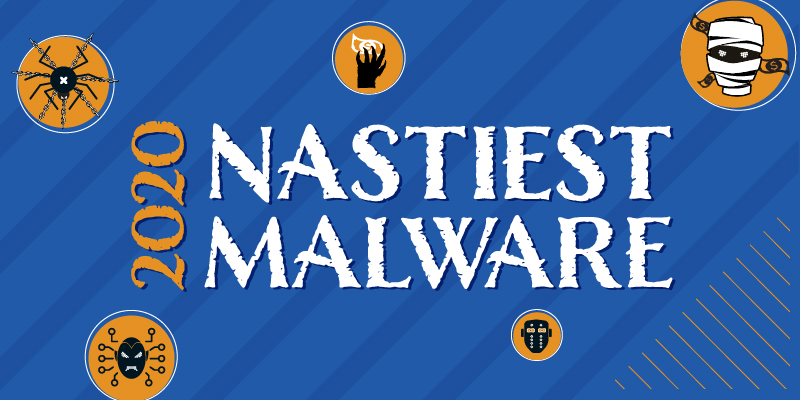Reading Time: ~ 4 min.
For the third year running, we’ve examined the year’s biggest cyber threats and ranked them to determine which ones are the absolute worst. Somewhat unsurprisingly, phishing and RDP-related breaches remain the top methods we’ve seen cybercriminals using to launch their attacks. Additionally, while new examples of malware and cybercriminal tactics crop up each day, plenty of the same old players, such as ransomware, continue to get upgrades and dominate the scene.
For example, a new trend in ransomware this year is the addition of a data leak/auction website, where criminals will reveal or auction off data they’ve stolen in a ransomware attack if the victim refuses to pay. The threat of data exposure creates a further incentive for victims to pay ransoms, lest they face embarrassing damage to their personal or professional reputations, not to mention hefty fines from privacy-related regulatory bodies like GDPR.
But the main trend we’ll highlight here is that of modularity. Today’s malicious actors have adopted a more modular malware methodology, in which they combine attack methods and mix-and-match tactics to ensure maximum damage and/or financial success.
Here are a few of nastiest characters and a breakdown of how they can work together.
- Emotet botnet + TrickBot Trojan + Conti/Ryuk
ransomware
There’s a reason Emotet has topped our list for 3 years in a row. Even though it’s not a ransomware payload itself, it’s the botnet that is responsible for the most ransomware infections, making it pretty darn nasty. It’s often seen with TrickBot, Dridex, QakBot, Conti/Ryuk, BitPaymer and REvil.Here’s how an attack might start with Emotet and end with ransomware. The botnet is used in a malicious spam campaign. An unwitting employee at a company receives the spam email, accidentally downloads the malicious payload. With its foot in the door, Emotet drops TrickBot, an info-stealing Trojan. TrickBot spreads laterally through the network like a worm, infecting every machine it encounters. It “listens” for login credentials (and steals them), aiming to get domain-level access. From there, attackers can perform recon on the network, disable protections, and drop Conti/Ryuk ransomware at their leisure.
- Ursnif Trojan + IcedID Trojan + Maze
ransomware
Ursnif, also known as Gozi or Dreambot, is a banking Trojan that has resurfaced after being mostly dormant for a few years. In an attack featuring this troublesome trio, Ursnif might land on a machine via a malicious spam email, botnet, or even TrickBot, and then drop the IcedID Trojan to improve the attackers’ chances of getting the credentials or intel they want. (Interestingly, IcedID has been upgraded to use steganographic payloads. Steganography in malware refers to concealing malicious code inside another file, message, image or video.) Let’s say the Trojans obtain the RDP credentials for the network they’ve infected. In this scenario, the attackers can now sell those credentials to other bad actors and/or deploy ransomware, typically Maze. (Fun fact: Maze is believed to have “pioneered” the data leak/auction website trend.)
- Dridex/Emotet malspam + Dridex Trojan + BitPaymer/DoppelPaymer ransomware
Like TrickBot, Dridex is another very popular banking/info-stealing Trojan that’s been around for years. When Dridex is in play, it is either dropped via Emotet or its authors’ own malicious spam campaign. Also like TrickBot, Dridex spreads laterally, listens for credentials, and typically deploys ransomware like BitPaymer/DoppelPaymer.
As you can see, there are a variety of ways the attacks can be carried out, but the end goal is the more or less the same. The diverse means just help ensure the likelihood of success.
The characters mentioned above are, by no means, the only names on our list. Here are some of the other notable contenders for Nastiest Malware.
- Sodinokibi/REvil/GandCrab ransomware – all iterations of the same ransomware, this ransomware as a service (RaaS) payload is available for anyone to use, as long as the authors get a cut of any successful ransoms.
- CrySiS/Dharma/Phobos ransomware – also RaaS payloads, these are almost exclusively deployed using compromised RDP credentials that are either brute-forced or easily guessed.
- Valak – a potent multi-functional malware distribution tool. Not only does it commonly distribute nasty malware such as IcedID and Ursnif, but it also has information stealing functionalities built directly into the initial infection.
- QakBot – an info-stealing Trojan often dropped by Emotet or its own malspam campaigns with links to compromised websites. It’s similar to TrickBot and Dridex and may be paired with ProLock ransomware.
Combine protections to combat combined attacks.
If businesses want to stay safe, they need to implement multiple layers of protection against these types of layered attacks. Here are some tips from our experts.
- Lock down RDP. Security analyst Tyler Moffitt says unsecured RDP has risen over 40% since the COVID-19 pandemic began because more businesses are enabling their workforce to work remotely. Unfortunately, many are not doing so securely. He recommends businesses use RDP solutions that encrypt the data and use multi-factor authentication to increase security when remoting into other machines.
- Educate end users about phishing. Principal product manager Phil Karcher points out that many of the attack scenarios listed above could be prevented with stronger phishing/spam awareness among end users. He recommends running regular security training and phishing simulations with useful feedback. He also says it’s critical that employees know when and how to report a suspicious message.
- Install reputable cybersecurity software. Security intelligence director Grayson Milbourne can’t stress enough the importance of choosing a solution that uses real-time threat intelligence and offers multi-layered shielding to detect and prevent multiple kinds of attacks at different attack stages.
- Set up a strong backup and disaster recovery plan. VP of product management Jamie Zajac says that, particularly with a mostly or entirely remote workforce, businesses can’t afford not to have a strong backup. She strongly recommends regular backup testing and setting alerts and regular reporting so admins can easily see if something’s amiss.

About the Author
Justine Kurtz
Senior Copywriter
Justine Kurtz has crafted the voice of Webroot for nearly a decade. As senior copywriter, she partners with clients across the organization (and the globe) to communicate the value Webroot solutions bring to businesses, consumers, and technology partners alike.
